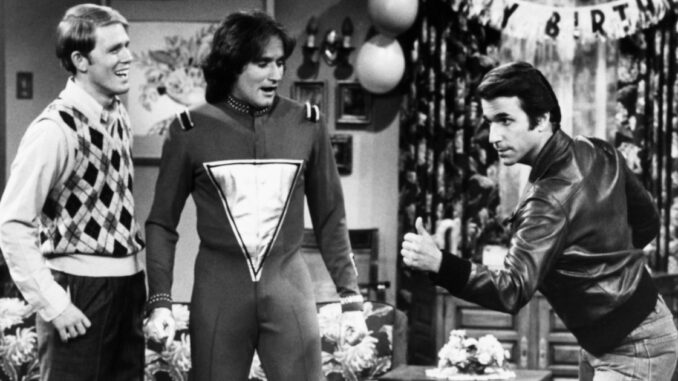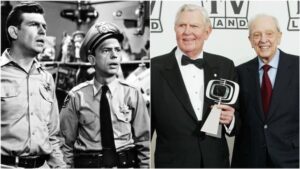
Introduction
Ever wondered why shows like ‘The Andy Griffith Show’ and ‘Happy Days’ continue to captivate audiences even decades after they aired? You’re not alone. These two sitcoms defined wholesome television, became cultural touchstones, and shaped the careers of some of Hollywood’s biggest names.
Let’s take a deep dive into the stories, secrets, and legacy behind these iconic series.
The Golden Age of Television
The 1960s and 1970s were the golden years for American sitcoms. With only a handful of channels and millions of viewers glued to their living rooms every evening, shows like The Andy Griffith Show and Happy Days didn’t just entertain—they shaped American values.
These shows captured the simplicity of small-town life and the youthful optimism of post-war America. But there’s so much more beneath the surface.
Overview of ‘The Andy Griffith Show’
Premiering in 1960, ‘The Andy Griffith Show’ was set in the fictional town of Mayberry, North Carolina. It starred Andy Griffith as Sheriff Andy Taylor and followed his everyday life as a single father and town sheriff.
The show stood out not for its action, but for its calm pace, subtle humor, and moral clarity. It was less about crime and more about community, friendship, and family.
Overview of ‘Happy Days’
Jump ahead to 1974 and you get ‘Happy Days’, a sitcom created by Garry Marshall that celebrated the 1950s. It was centered around Richie Cunningham (played by Ron Howard) and his friends navigating teenage life in Milwaukee.
What started as a nostalgic look back quickly became a pop culture phenomenon, largely thanks to the rise of Arthur “The Fonz” Fonzarelli, played by Henry Winkler.
The Small-Town Charm of Mayberry
Mayberry felt like a dream. A town where everyone knew your name, where the sheriff didn’t carry a gun, and where problems were solved with heart and humor. The town became a symbol of idealized American life.
But what made it even more powerful was its subtle commentary on real-world issues—without ever becoming preachy.

The Nostalgic Appeal of Milwaukee in the ’50s
While Mayberry represented timeless small-town values, Milwaukee in ‘Happy Days’ gave viewers a fun, fast-paced look at post-war youth culture.
It had diners, jukeboxes, leather jackets, and sock hops. It was the show that romanticized the idea of growing up in the ‘50s. Yet, it wasn’t all slicked hair and cool dance moves—beneath the surface, it dealt with themes like friendship, loyalty, and growing pains.
Behind-the-Scenes: What Wasn’t on Camera
Here’s where it gets juicy. Did you know that Andy Griffith originally didn’t want Don Knotts on the show permanently? Or that ‘Happy Days’ was almost canceled after its second season?
Both shows had their fair share of tension, last-minute casting decisions, and creative clashes—but that’s what makes them legendary. The stories behind the camera are sometimes more dramatic than the episodes themselves.
The Stars Who Shaped the Shows
Andy Griffith was a Southern storyteller at heart, while Ron Howard matured in front of America’s eyes. Don Knotts brought comedic brilliance, and Henry Winkler accidentally created a national icon with The Fonz.
Each actor brought a unique flavor, shaping not only their own show but leaving an imprint on American pop culture.
Andy Griffith and Ron Howard: A Lifelong Bond
Onscreen, they were father and son. Offscreen? Almost the same.
Ron Howard has repeatedly said that Andy Griffith was a mentor, often teaching him about pacing, delivery, and professional discipline. This early mentorship helped launch Howard’s later career as an acclaimed director.
Ron Howard’s Transition From Opie to Richie
Think about this for a moment: Ron Howard went from playing the young, innocent Opie Taylor to the teenage, eager Richie Cunningham—and nailed both roles.
This transition wasn’t just about age. It showed Howard’s range as an actor and proved his staying power in the industry.
Don Knotts’ Impact on Comedy
Let’s not beat around the bush—Barney Fife is one of the funniest characters ever written.
Don Knotts’ high-strung, overconfident deputy gave the show its comedic edge. His physical comedy, timing, and expressions were masterful. He even won five Emmys for the role, and rightly so.
Henry Winkler’s Journey to Becoming The Fonz
Originally written as a minor character, The Fonz quickly became the heart and soul of ‘Happy Days’. Viewers couldn’t get enough of the leather jacket, the motorcycle, and the “Ayyy!”
But behind the scenes, Henry Winkler was a classically trained actor who struggled with dyslexia and insecurities. His story is a testament to perseverance and redefining “cool.”
The Life Lessons Hidden in the Laugh Tracks
Sure, these shows made you laugh. But they also made you think.
‘The Andy Griffith Show’ taught patience, honesty, and kindness. ‘Happy Days’ reminded us of the ups and downs of adolescence—and the importance of sticking together.
There were lessons buried in every episode, cleverly wrapped in humor and warmth.
Why Audiences Still Connect With These Shows
So, what’s the magic ingredient?
Simplicity, heart, and relatability.
These weren’t shows filled with explosions or cliffhangers. They were about life’s small moments—helping a friend, raising a child, finding your way. And that’s why they’ve stood the test of time.
The Evolution of Family TV From the ‘60s to the ‘70s
TV didn’t just change visually from black-and-white to color. It also matured.
‘The Andy Griffith Show’ showcased a slower, more reflective pace of life. ‘Happy Days’ sped things up, capturing the energy of a changing America.
Together, they paint a complete picture of two decades worth of shifting values and styles.
Reboots, Revivals, and Legacy
Both shows have sparked reunions, spin-offs, and even fan conventions. ‘The Andy Griffith Show’ led to ‘Mayberry R.F.D.’ while ‘Happy Days’ spun off hits like ‘Laverne & Shirley’ and ‘Mork & Mindy’.
Even today, their reruns draw huge audiences, proving that good storytelling never goes out of style.
Conclusion
In the end, ‘The Andy Griffith Show’ and ‘Happy Days’ are more than just old TV shows. They’re reflections of who we were, who we wanted to be, and who we sometimes still wish we were.
These shows brought us laughter, lessons, and unforgettable characters. And whether you were team Mayberry or team Milwaukee, they’ll always hold a special place in American television history.
FAQs
1. Did Ron Howard appear on both ‘The Andy Griffith Show’ and ‘Happy Days’?
Yes! He played Opie Taylor in The Andy Griffith Show and later starred as Richie Cunningham in Happy Days.
2. Was ‘Happy Days’ based on real events?
Not exactly, but it was inspired by nostalgia for the 1950s and drew from creator Garry Marshall’s own upbringing.
3. Why did Don Knotts leave ‘The Andy Griffith Show’?
He believed Andy Griffith was ending the series after five seasons, so he signed a movie deal. When the show continued, it was too late.
4. Was The Fonz supposed to be a main character?
No, he was initially a minor role, but Henry Winkler’s performance made him a fan favorite—and the show’s centerpiece.
5. Can you still watch these shows today?
Absolutely. Both are widely available on streaming platforms, DVD collections, and air regularly on networks like MeTV.
